Scottish Marine and Freshwater Science Volume 4 Number 2: Connectivity of benthic priority marine species within the Scottish MPA network
A biophysical modelling approach that accounts for regional oceanographic variation and some degree of biological realism was used to estimate larval transport of 18 benthic invertebrates identified as priority marine features for possible nature conserva
Results
Cnidaria
Tall Sea Pen ( Funiculina quadrangularis)
As tall sea pen spawn between October and January and the PLD and settlement competency period of a similar species is 65 days, in our connectivity simulations tall sea pens were assumed to spawn in autumn and winter, with a settlement window of 28-65 days. Based on presence data, particles were released from the following MPAs: SMI, NWS, CFL, CFL, SSH, GSH and BHT.
Figure 3a shows the distribution of particles at the end of the settlement window (right panels) and identifies the MPAs locations that these particles drifted over during that period (left panels) for each of the spawning periods (top: autumn; bottom: winter). The potential widespread distribution of offspring and the significant connectivity potential is the result of its relatively long pelagic larval duration ( PLD) period. An index of the distance covered by the larvae in their PLD is presented in Table 3.
Figure 3a: Black dots show the distribution of particles at the end of the settlement window (right panels) and MPAs locations that these particles drifted over during that period (left panels) for each of the spawning periods (top: autumn; bottom: winter). Red dots show the particle origin positions.
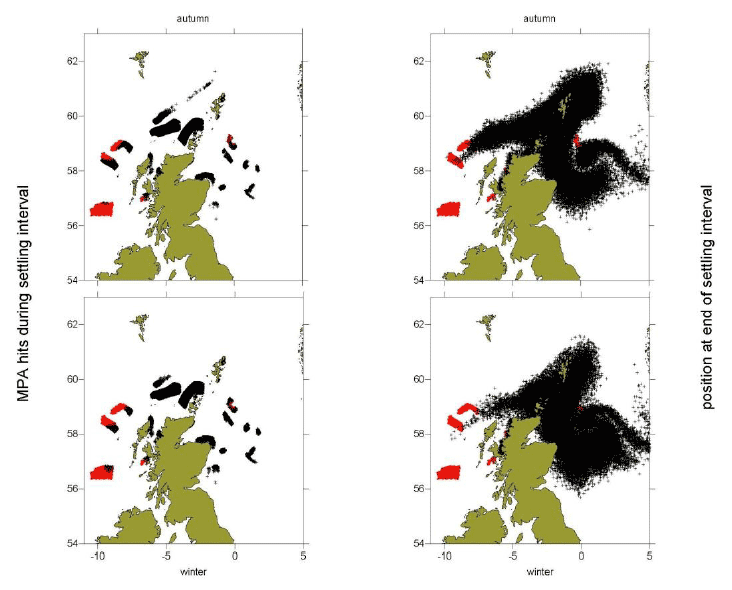
Table 3
Mean and standard deviation of the distance (straight line) between start and end position, for each particle representing tall sea pen larvae released from each origin MPA, for each spawning season (n is the number of particles released).
| MPA | Autumn | Winter | n | ||
|---|---|---|---|---|---|
| mean | stdev | mean | stdev | ||
| SMI | 398.7342 | 186.2706 | 472.1786 | 245.7127 | 2400 |
| NWS | 541.8706 | 155.5513 | 664.4572 | 138.8007 | 1200 |
| CFL | 161.4177 | 109.0815 | 257.1189 | 209.5545 | 2900 |
| CFL | 247.5095 | 208.9594 | 475.5425 | 265.7354 | 1000 |
| SSH | 842.7279 | 94.4515 | 837.1288 | 97.0671 | 8300 |
| GSH | 905.5469 | 88.51035 | 959.7132 | 111.8897 | 9100 |
| BHT | 735.0193 | 130.9657 | 801.8007 | 101.1855 | 18700 |
The results on Table 3 show considerable variability between MPAs (e.g. those from Geikie Slide and Hebridean Slope ( GSH) cover considerably longer distance than those from Central Fladen ( CFL). Particles released in winter tend to cover longer distances but display greater variability, compared to those in the autumn.
Figure 3b shows a connectivity matrix between origin and (potential) destination MPAs, confirming the pattern that, in the case of tall sea pens, west coast MPAs are considerably more dispersive than North Sea ones.
Figure 3b: Matrix showing the percentage of all particles representing tall sea pen released from each origin MPA drifting over any MPA during the settlement period of their pelagic phase. Grey boxes indicate zero hits.
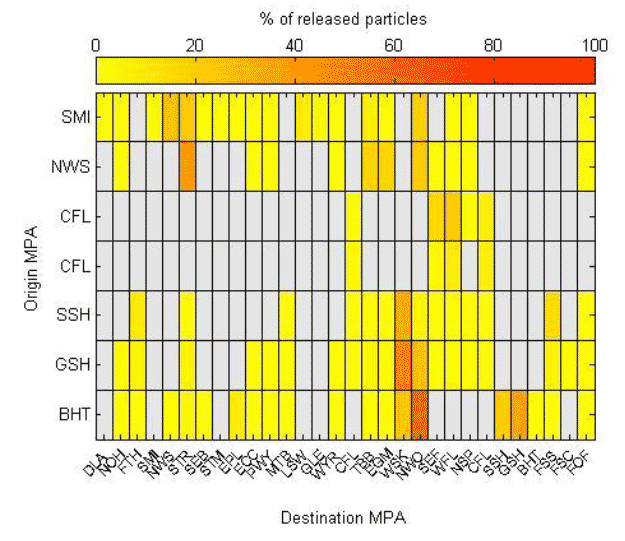
Northern Sea Fan ( Swiftia pallida)
As the plannular larvae of the northern sea fan, Swiftia pallida, are thought to be have a short pelagic larval duration we assumed a settlement window of one to ten days with spawning in summer and winter. Based on presence data, particles were released from the following MPAs: SMI, SEB, STM, LSW, TBB and FOF.
Figure 4a shows the distribution of particles at the end of the settlement window (right panels) and identifies the MPAs locations that these particles drifted over during that period (left panels) for each of the spawning periods (top: summer; bottom: winter). The potential relatively narrow distribution of offspring and the reduced connectivity potential, including a considerable degree of self-recruitment (see also Figure 4b), is the result of its relatively short PLD period. An index of the distance covered by the larvae in their PLD is presented in Table 4.
Figure 4a: Black dots show the distribution of particles at the end of the settlement window (right panels) and MPAs locations that these particles drifted over during that period (left panels) for each of the spawning periods (top: summer; bottom: winter). Red dots show the particle origin positions.
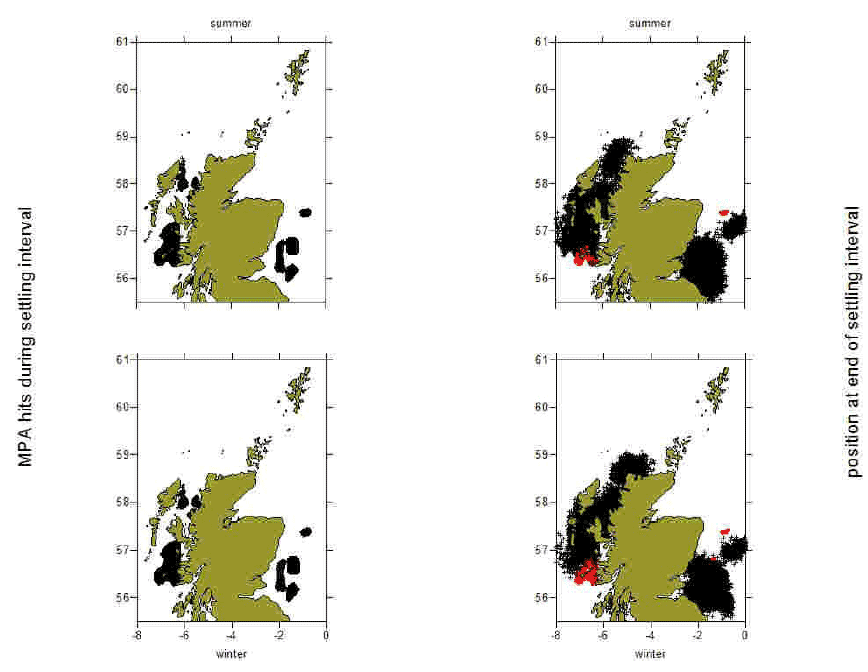
Table 4
Mean and standard deviation of the distance (straight line) between start and end position, for each particle representing northern sea fan larvae released from each origin MPA, for each spawning season (n is the number of particles released).
| MPA | Summer | Winter | n | ||
|---|---|---|---|---|---|
| mean | stdev | mean | stdev | ||
| SMI | 58.93132 | 33.395 | 223.0987 | 136.1454 | 2400 |
| SEB | 83.58833 | 22.53601 | 388.1834 | 63.63042 | 1200 |
| STM | 72.56669 | 28.09435 | 237.0058 | 121.064 | 14100 |
| LSW | 21.96786 | 22.63312 | 72.0195 | 37.45215 | 100 |
| TBB | 64.69743 | 16.32645 | 135.9349 | 28.97287 | 800 |
| FOF | 32.82873 | 15.25553 | 112.5105 | 45.14544 | 8300 |
The results on Table 4 show quite a lot of variability between MPAs (e.g. those from Loch Sween ( LSW) cover considerably shorter average distances than those from Shiant East Bank ( SEB)). Particles released in winter tend to cover considerably longer distances but display greater variability in general, compared to those in the summer.
Figure 4b shows a connectivity matrix between origin and (potential) destination MPAs, confirming the pattern that, in the case of northern sea fans, west coast MPAs are considerably more dispersive than North Sea ones but, overall, the dispersal potential of this species is limited.
Figure 4b: Matrix showing the percentage of all particles representing northern sea fan released from each origin MPA drifting over any MPA during the settlement period of their pelagic phase. Grey boxes indicate zero hits.
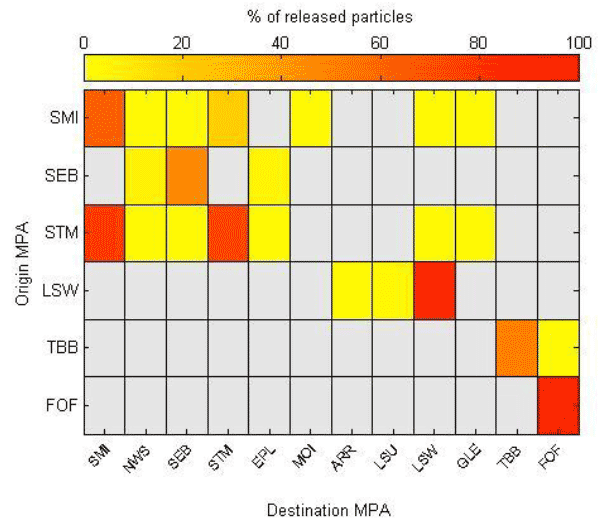
Pink Soft Coral ( Alcyonium hibernicum)
Pink soft coral and pink sea fingers spawn in late summer between August and September and the plannular larvae settle shortly after release. So, for the purpose of our connectivity simulations, pink soft corals were assumed to spawn in summer, with a settlement window of one to ten days. Based on presence data, particles were released from the following MPAs: CSS, STM and LSW.
Figure 5a shows the distribution of particles at the end of the settlement window (right panel) and identifies the MPAs locations that these particles drifted over during that period (left panel). The potential distribution of offspring is quite limited, resulting from a short PLD period and limited distribution at origin within the proposed MPAs. An index of the distance covered by the larvae in their PLD is presented in Table 5.
Figure 5a: Black dots show the distribution of particles at the end of the settlement window (right panel) and MPAs locations that these particles drifted over during that period (left panel). Red dots show the particle origin positions.
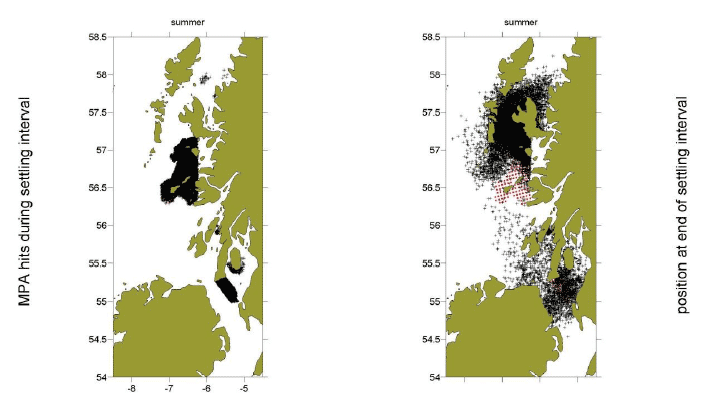
Table 5
Mean and standard deviation of the distance (straight line) between start and end position, for each particle representing pink soft coral larvae released from each origin MPA (n is the number of particles released).
| MPA | Summer | n | |
|---|---|---|---|
| mean | stdev | ||
| CSS | 41.40528 | 27.13667 | 2800 |
| STM | 68.07873 | 27.38209 | 14100 |
| LSW | 16.73283 | 17.34437 | 100 |
The results on Table 5 show some differences between MPAs, which reflect their location (the closer inshore, the less dispersive).
Figure 5b shows a connectivity matrix between origin and (potential) destination MPAs. There is a considerable degree of self-recruitment, as a result of relatively inshore MPA locations and short PLD.
Figure 5b: Matrix showing the percentage of all particles representing pink soft coral released from each origin MPA drifting over any MPA during the settlement period of their pelagic phase. Grey boxes indicate zero hits.
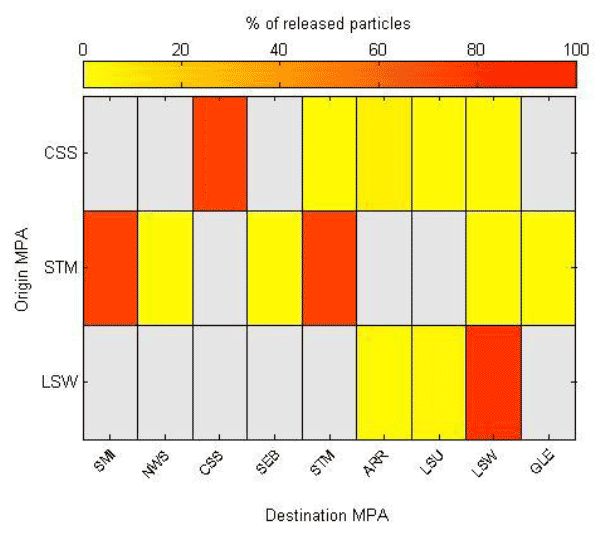
Burrowing Sea Anemone ( Arachnanthus sars)
The larvae of the Burrowing anemone ( Arachnanthus sarsi) are present in the plankton from April to the autumn so we assumed spawning was in spring, summer and autumn. As the PLD of the related Cerianthus species range from four weeks to four months we used a settlement window of 28-90 days. Based on presence data, particles were released from the following MPAs: SMI, NWS, STM, EPL, CFL, NWO, SEF, WFL, NSP, CFL, SSH, GSH and BHT.
Figure 6a shows the distribution of particles at the end of the settlement window (three right panels) and identifies the MPA locations that these particles drifted over during that period (three left panels) for each of the three spawning periods (spring to autumn). The potential distribution of offspring and between- MPA connectivity are extremely wide, as a result of a relatively long PLD period and widespread distribution at origin within the proposed MPAs. An index of the distance covered by the larvae in their PLD is presented in Table 6.
Figure 6a: Black dots show the distribution of particles at the end of the settlement window (three right panels) and MPAs locations that these particles drifted over during that period (three left panels) for each of the spawning periods (top: spring and autumn; bottom: summer). Red dots show the particle origin positions.
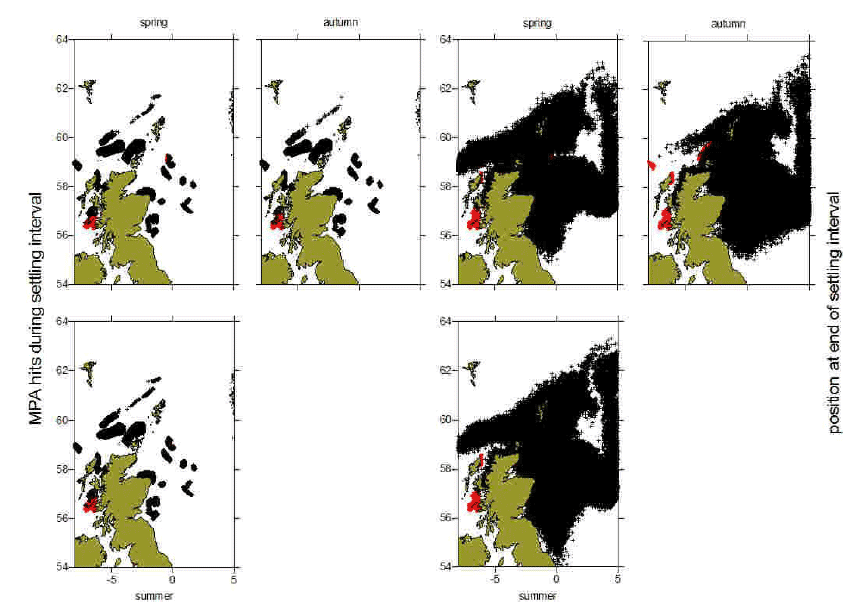
Table 6
Mean and standard deviation of the distance (straight line) between start and end position, for each particle representing burrowing sea anemone larvae released from each origin MPA, for each spawning season (n is the number of particles released).
| MPA | spring | summer | autumn | n | |||
|---|---|---|---|---|---|---|---|
| mean | stdev | mean | stdev | mean | stdev | ||
| SMI | 262.7722 | 99.05911 | 255.1555 | 123.6793 | 376.8256 | 131.2515 | 2400 |
| NWS | 296.6722 | 92.02234 | 330.6136 | 89.24955 | 465.8216 | 111.2949 | 1200 |
| STM | 288.2795 | 90.58127 | 284.4247 | 111.7464 | 385.4184 | 120.9899 | 14100 |
| EPL | 431.3364 | 98.19427 | 470.2425 | 91.2673 | 566.0165 | 127.0553 | 2200 |
| CFL | 164.8757 | 128.6385 | 178.141 | 133.9859 | 202.9292 | 133.3907 | 2900 |
| NWO | 497.0089 | 122.4901 | 501.516 | 106.2314 | 537.7676 | 118.4944 | 17500 |
| SEF | 317.3321 | 86.67873 | 385.8749 | 96.25372 | 390.7663 | 102.9626 | 1700 |
| WFL | 268.6549 | 163.4696 | 273.0761 | 141.7989 | 346.1803 | 118.9167 | 3000 |
| NSP | 360.5706 | 86.3769 | 399.9785 | 109.7099 | 427.3958 | 95.44053 | 800 |
| CFL | 175.232 | 143.4311 | 184.7308 | 140.4058 | 220.932 | 134.978 | 1000 |
| SSH | 520.0574 | 76.05066 | 538.3254 | 80.94968 | 543.814 | 83.85678 | 8300 |
| GSH | 575.8729 | 73.28264 | 584.3992 | 72.81853 | 599.6261 | 78.29477 | 9100 |
| BHT | 504.5871 | 122.0041 | 544.7715 | 108.1969 | 615.5512 | 69.10734 | 18700 |
The results on Table 6 confirm the general patterns observed for other species, i.e. that offshore MPAs tend to be more dispersive than inshore ones, and offspring spawned in west coast MPAs tend to cover greater distances than those in the North Sea. Autumn spawned larvae also tend to travel further than those spawned earlier in the year.
Figure 6b shows a connectivity matrix between origin and (potential) destination MPAs. The results are consistent with the patterns described above (Figure 6a and Table 6).
Figure 6b: Matrix showing the percentage of all particles representing burrowing sea anemone released from each origin MPA drifting over any MPA during the settlement period of their pelagic phase. Grey boxes indicate zero hits.
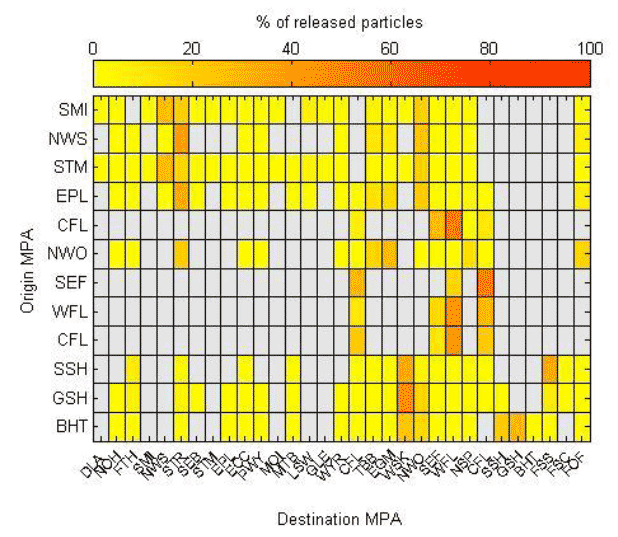
Mollusca
Horse Mussel ( Modiolus modiolus)
The bivalve Modiolus modiolus has peaks of spawning in spring and early summer and the planktonic veliger stage duration was found to take approximately 38 days. So, for the purpose of our connectivity simulations, horse mussels were assumed to spawn all year-round, with a settlement window of 30-40 days. Based on presence data, particles were released from the following MPAs: NOH, FTH and SMI.
Figure 7a shows the distribution of particles at the end of the settlement window (right panels) and identifies the MPAs locations that these particles drifted over during that period (left panels) for each of the spawning periods (rows from the top: spring, summer, autumn and winter, respectively). The potential distribution of offspring is relatively wide but connectivity potential is not very strong (see Figure 7b too), resulting from a relatively long PLD period but limited distribution at origin within the proposed MPAs. An index of the distance covered by the larvae in their PLD is presented in Table 7.
Figure 7a: Black dots show the distribution of particles at the end of the settlement window (right panels) and MPAs locations that these particles drifted over during that period (left panels) for each of the spawning periods (rows from the top: spring to winter). Red dots show the particle origin positions.
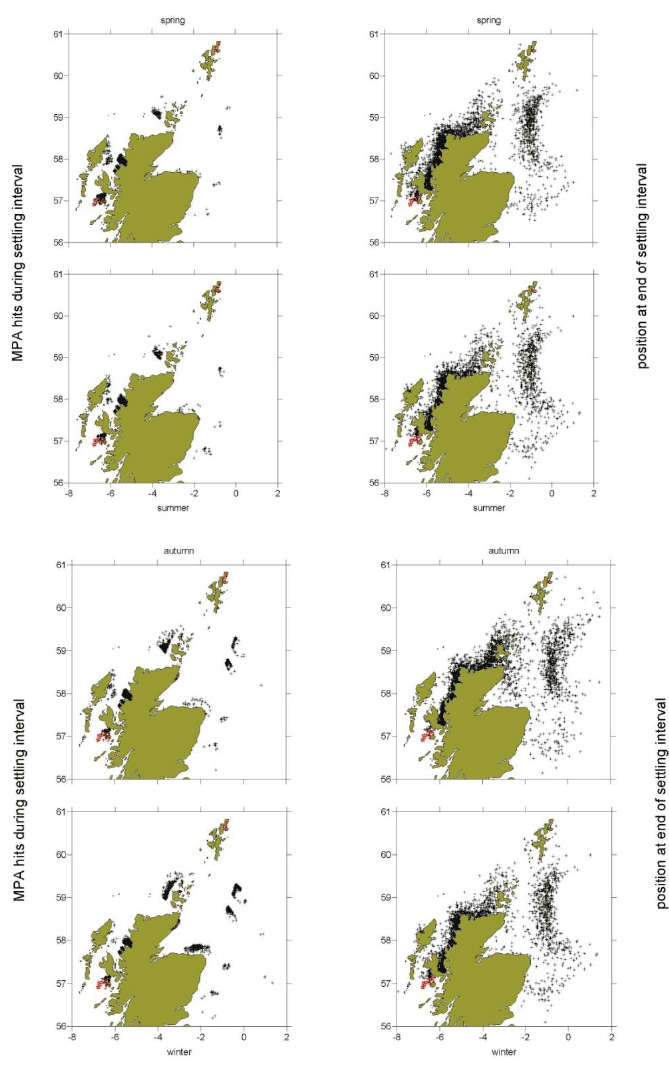
Table 7
Mean and standard deviation of the distance (straight line) between start and end position, for each particle representing horse mussel larvae released from each origin MPA, for each spawning season (n is the number of particles released).
| MPA | spring | summer | autumn | winter | n | ||||
|---|---|---|---|---|---|---|---|---|---|
| mean | stdev | mean | stdev | mean | stdev | mean | stdev | ||
| NOH | 249.0141 | 83.19418 | 232.8721 | 84.93978 | 260.3104 | 78.66676 | 281.9295 | 77.72447 | 100 |
| FTH | 213.35 | 60.20469 | 221.2325 | 69.44247 | 216.3795 | 54.13975 | 220.4248 | 43.37147 | 600 |
| SMI | 178.4879 | 106.1896 | 176.5887 | 109.0172 | 246.9048 | 131.9025 | 292.0999 | 165.5732 | 2400 |
The results on Table 7 show relatively small differences between MPAs and seasons, compared to other species.
Figure 7b shows a connectivity matrix between origin and (potential) destination MPAs. As with other species, the west coast MPA is more dispersive than North Sea ones although this could be partly due to the distribution of MPAs along the west coast, since the dispersal distances were not very different between areas.
Figure 7b: Matrix showing the percentage of all particles representing horse mussel released from each origin MPA drifting over any MPA during the settlement period of their pelagic phase. Grey boxes indicate zero hits.
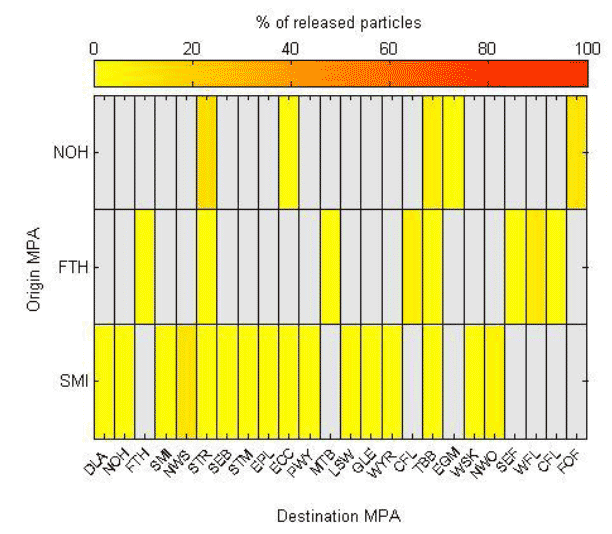
Ocean Quahog ( Arctica islandica)
As spawning in the ocean quahog is protracted and the duration of the larval phase is approximately 32-55 days we assumed spawning was in summer and autumn, with a settlement window of 40-60 days for the purpose of our connectivity simulations. Based on presence data, particles were released from the following MPAs: NWS, STR, ARR, GLE, EGM, WFL, NSP, BHT, FSS and FOF.
Figure 8a shows the distribution of particles at the end of the settlement window (right panels) and identifies the MPAs locations that these particles drifted over during that period (left panels) for each of the spawning periods (top: spring; bottom: summer). The potential distribution of offspring is very wide and connectivity potential is considerable (see also Figure 8b), as a result of the long PLD period and extensive distribution at origin within the proposed MPAs. An index of the distance covered by the larvae in their PLD is presented in Table 8.
Figure 8a: Black dots show the distribution of particles at the end of the settlement window (right panels) and MPAs locations that these particles drifted over during that period (left panels) for each of the spawning periods (top: summer; bottom: autumn). Red dots show the particle origin positions.
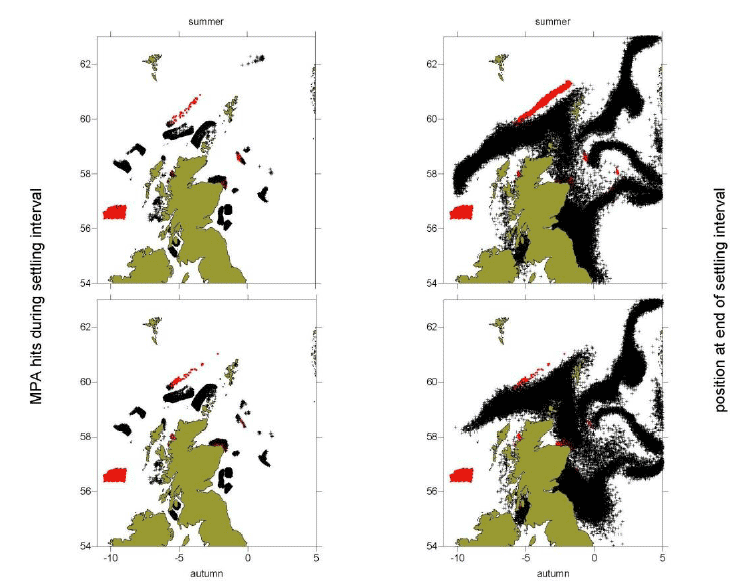
Table 8
Mean and standard deviation of the distance (straight line) between start and end position, for each particle representing ocean quahog larvae released from each origin MPA, for each spawning season (n is the number of particles released).
| MPA | Summer | Autumn | n | ||
|---|---|---|---|---|---|
| mean | stdev | mean | stdev | ||
| NWS | 210.3894 | 71.44167 | 301.467 | 87.5921 | 1200 |
| STR | 197.8751 | 71.33853 | 212.3195 | 44.46416 | 7600 |
| ARR | 75.12121 | 62.87876 | 50.64271 | 51.43547 | 1300 |
| GLE | 202.6309 | 55.94869 | 280.0399 | 80.62585 | 300 |
| EGM | 304.72 | 114.9622 | 221.5995 | 96.61362 | 3800 |
| WFL | 163.6299 | 106.9408 | 254.4092 | 114.8778 | 3000 |
| NSP | 336.094 | 139.4325 | 292.0905 | 125.6298 | 800 |
| BHT | 349.156 | 131.5106 | 471.0206 | 80.57485 | 18700 |
| FSS | 416.9898 | 81.69673 | 397.0485 | 94.58714 | 25500 |
| FOF | 110.676 | 53.35329 | 113.9773 | 52.88048 | 8300 |
The results on Table 8 show wide differences between MPAs (e.g. considerable distances covered by larvae originating from offshore MPAs such as the Faroe-Shetland Sponge Belt ( FSS) but smaller in the case of more coastal MPA, with Arran ( ARR) as an extreme example. The differences between seasons are not very large, nor are there consistent patterns between MPAs.
Figure 8b shows a connectivity matrix between origin and potential destination MPAs. As with other species, the west coast MPA is more dispersive than North Sea ones although this could be partly due to the distribution of MPAs along the west coast. The patterns observed for dispersal distance were not particularly obvious in the connectivity matrix, probably masked by the east-west coast differences mentioned above.
Figure 8b: Matrix showing the percentage of all particles representing ocean quahog released from each origin MPA drifting over any MPA during the settlement period of their pelagic phase. Grey boxes indicate zero hits.
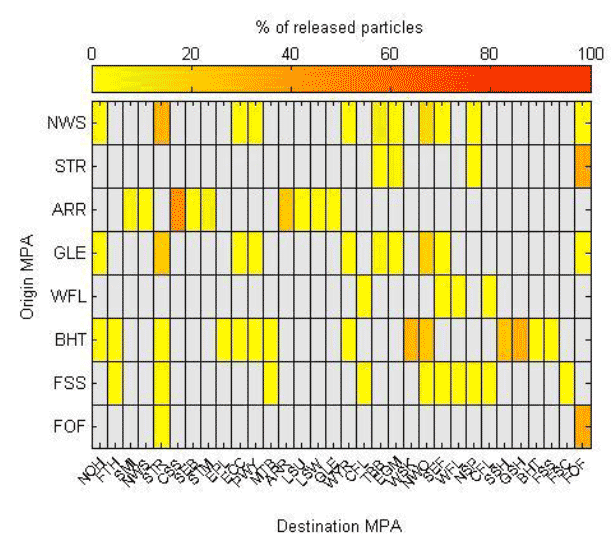
Fan Mussel ( Atrina fragilis)
Fan mussels have been reported to spawn in the summer so we assumed spawning was from spring to autumn, with a settlement window of 30-50 days. Based on presence data, particles were released from the following MPAs: SMI, CSS and ARR.
Figure 9a shows the distribution of particles at the end of the settlement window (right three panels) and identifies the MPAs locations that these particles drifted over during that period (left three panels) for each of the three spawning periods (spring, autumn and winter). The potential distribution of offspring is quite wide, with origin MPAs in the west coast potentially being able to contribute offspring to areas in the north and the east, as a result of a relatively long PLD period. An index of the distance covered by the larvae in their PLD is presented in Table 9.
Figure 9a: Black dots show the distribution of particles at the end of the settlement window (three right panels) and MPAs locations that these particles drifted over during that period (three left panels) for each of the spawning periods (top: spring and autumn; bottom: summer). Red dots show the particle origin positions.
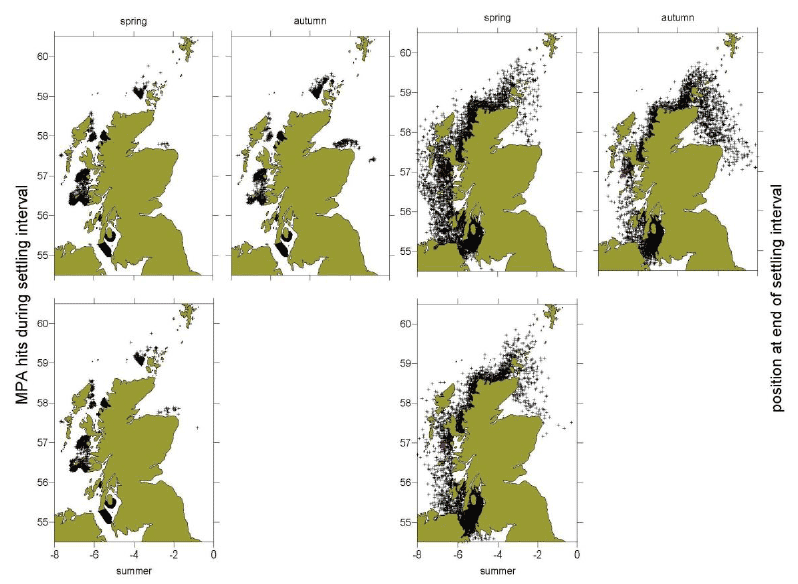
Table 9
Mean and standard deviation of the distance (straight line) between start and end position, for each particle representing fan mussel larvae released from each origin MPA, for each spawning season (n is the number of particles released).
| MPA | spring | summer | autumn | n | |||
|---|---|---|---|---|---|---|---|
| mean | stdev | mean | stdev | mean | stdev | ||
| SMI | 215.0326 | 122.1579 | 215.8706 | 132.1664 | 303.2008 | 150.6005 | 2400 |
| CSS | 133.2396 | 100.5229 | 103.1948 | 93.99843 | 89.98832 | 88.15232 | 2800 |
| ARR | 110.5772 | 84.0085 | 82.20794 | 62.74385 | 55.20894 | 50.6603 | 1300 |
The results on Table 9 show a range of average distances that reflects the inshore-offshore gradient of origin. The results are quite variable and there are seasonal differences without a clear pattern between MPAs.
Figure 9b shows a connectivity matrix between origin and (potential) destination MPAs. The results are consistent with the patterns observed in Figure 9a. The matrix also shows, as expected, a greater degree of self-recruitment within Clyde Sea MPAs.
Figure 9b: Matrix showing the percentage of all particles representing fan mussel released from each origin MPA drifting over any MPA during the settlement period of their pelagic phase. Grey boxes indicate zero hits.
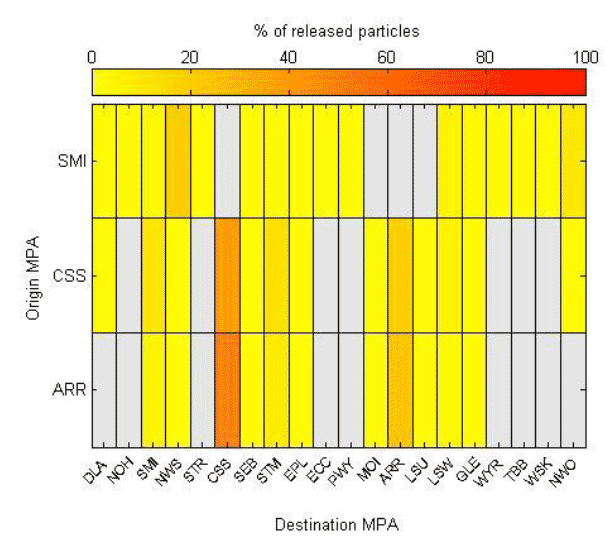
Native Oyster ( Ostrea edulis)
As the larvae of the native oyster are pelagic for 11-30 days, we used a settlement window of 10-30 days, with spawning in the summer. Based on presence data, particles were released from the following MPAs: NWS, STM, LSW, GLE and WYR.
Figure 10a shows the distribution of particles at the end of the settlement window (right panel) and identifies the MPAs locations that these particles drifted over during that period (left panel). Even though the origin MPAs are all on the west coast, the potential distribution of offspring is relatively wide, resulting from a relatively long PLD period. An index of the distance covered by the larvae in their PLD is presented in Table 10.
Figure 10a: Black dots show the distribution of particles at the end of the settlement window (right panel) and MPAs locations that these particles drifted over during that period (left panel). Red dots show the particle origin positions.

Table 10
Mean and standard deviation of the distance (straight line) between start and end position, for each particle representing native oyster larvae released from each origin MPA, for each spawning season (n is the number of particles released).
| MPA | summer | n | |
|---|---|---|---|
| mean | stdev | ||
| NWS | 163.35 | 78.06062 | 1200 |
| STM | 162.339 | 73.02932 | 14100 |
| LSW | 62.05346 | 41.44984 | 100 |
| GLE | 151.0637 | 67.76181 | 300 |
| WYR | 244.9038 | 89.90069 | 100 |
The results on Table 10 show relatively small differences between MPAs, considering that some of these were very small areas, where only small numbers of particles were released (one to three release positions for three of the origin MPAs).
Figure 10b shows a connectivity matrix between origin and (potential) destination MPAs. The results show the potential for relatively long distance transport. Relatively large connectivity values may have been influenced by the small size of some origin MPAs and, consequently, the small number of particles released from those.
Figure 10b: Matrix showing the percentage of all particles representing native oyster released from each origin MPA drifting over any MPA during the settlement period of their pelagic phase. Grey boxes indicate zero hits.
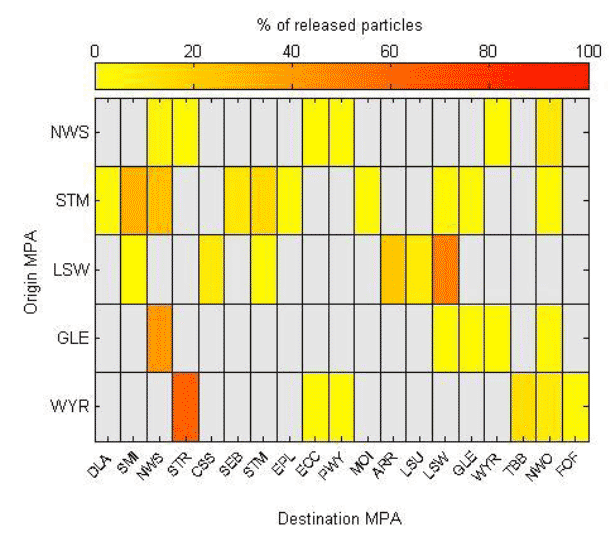
Flame Shell ( Limaria hians)
Flame shell spawn from May-June with peak settlement from July-August in Scottish waters so, for the purpose of our connectivity simulations, flame shell were assumed to spawn in summer, with a settlement window of 20-60 days. Based on presence data, particles were released only from NWS MPA (North-west sea lochs and Summer Isles).
Figure 11 shows the distribution of particles at the end of the settlement window (right) and identifies the MPAs locations that these particles drifted over during that period (left). The potential distribution of offspring is relatively wide, considering the restricted origin, as offspring can potentially reach northern and eastern MPAs. An index of the distance covered by the larvae in their PLD is presented in Table 11a.
Figure 11: Black dots show the distribution of particles at the end of the settlement window (right panel) and MPAs locations that these particles drifted over during that period (left panel). Red dots show the particle origin positions.

Table 11a
Mean and standard deviation of the distance (straight line) between start and end position, for each particle representing flame shell larvae released from the origin MPA (n is the number of particles released).
| MPA | summer | n | |
|---|---|---|---|
| mean | stdev | ||
| NWS | 210.3894 | 71.44167 | 1200 |
Table 11a is not very informative because only one MPA and season were considered, and the distance between the origin and end-point of the particles ignore the fact that many travelled a considerably longer distance, around the northern coast of Scotland (mainland and northern isles, as it can be inferred from Figure 11).
Instead of a highly one-dimensional connectivity matrix between the single origin MPA and all other (potential) destination MPAs, the percentage of all particles representing flame shell larvae that drift over any MPA during the settlement period of their pelagic phase is presented in Table 11b. The results confirm the patterns observed in Figure 11.
Table 11b
Percentage of all particles representing flame shell larvae released from the origin MPA that drift over any MPA during the settlement period of their pelagic phase.
| Destination | |||||||||
|---|---|---|---|---|---|---|---|---|---|
| Origin | NOH | NWS | STR | ECC | PWY | WYR | TBB | NWO | FOF |
| NWS | 1.083 | 0.667 | 37.25 | 2.833 | 1.75 | 0.667 | 5.417 | 30.58 | 1.5 |
Heart Cockle ( Glossus humanus)
In the Clyde, heart cockle probably spawn at the end of September and their larvae tend to be in the plankton for a few weeks. Therefore, we assumed that heart cockles spawn in autumn, with a settlement window of 1-30 days. Based on presence data, particles were released from a single MPA: GLE.
Figure 12 shows the distribution of particles at the end of the settlement window (right panel) and identifies the MPAs locations that these particles drifted over during that period (left panel). The potential distribution of offspring is relatively wide but disperse, resulting from a moderately long PLD period but very limited distribution at origin within the proposed MPAs (only one small MPA in the simulations, only three distinct particle release positions). An index of the distance covered by the larvae in their PLD is presented in Table 12a.
Figure 12: Black dots show the distribution of particles at the end of the settlement window (right panel) and MPAs locations that these particles drifted over during that period (left panel). Red dots show the particle origin positions.
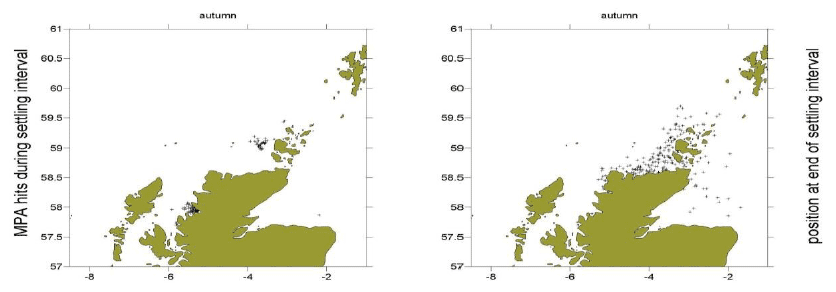
Table 12a
Mean and standard deviation of the distance (straight line) between start and end position, for each particle representing heart cockle larvae released from the origin MPA (n is the number of particles released).
| MPA | autumn | n | |
|---|---|---|---|
| mean | stdev | ||
| GLE | 157.583 | 47.71967 | 300 |
Instead of a highly one-dimensional connectivity matrix between the single origin MPA and all other (potential) destination MPAs, the percentage of all particles representing heart cockle larvae that drift over any MPA during the settlement period of their pelagic phase is presented in Table 12b. The results confirm the patterns observed in Fig. 12.
Table 12b
Percentage of all particles representing heart cockle larvae released from the origin MPA that drift over any MPA during the settlement period of their pelagic phase.
| Destination | ||||||
|---|---|---|---|---|---|---|
| Origin | NWS | STR | SEB | LSW | GLE | NWO |
| GLE | 87.00 | 0.33 | 0.67 | 14.00 | 15.67 | 12.00 |
Most of the heart cockle larvae are transported along the coast to MPA NWS, although other MPAs in the vicinity are also potentially visited and there is some self-recruitment. The offspring can potentially reach MPAs in Orkney and into the northern North Sea.
Arthropoda
Amphipod (Maera loveni)
As amphipods have no larval stages and dispersion is limited to crawling, swimming, and "rafting" on algae, we assumed these amphipods spawned all year-round, with a settlement window of one to ten days. Based on presence data, particles were released from the following MPAs: NWS, STR, ARR, GLE, EGM, WFL, NSP, BHT, FSS and FOF.
Figure 13a shows the distribution of particles at the end of the settlement window (right panels) and identifies the MPAs locations that these particles drifted over during that period (left panels) for each of the spawning periods (top to bottom: spring to winter). The potential distribution of offspring is very limited, as a result of the life history characteristics of this animal. An index of the distance covered by the offspring is presented in Table 13.
Figure 13a: Black dots show the distribution of particles at the end of the settlement window (right panels) and MPAs locations that these particles drifted over during that period (left panels) for each of the spawning periods (rows from the top: spring to winter). Red dots show the particle origin positions.
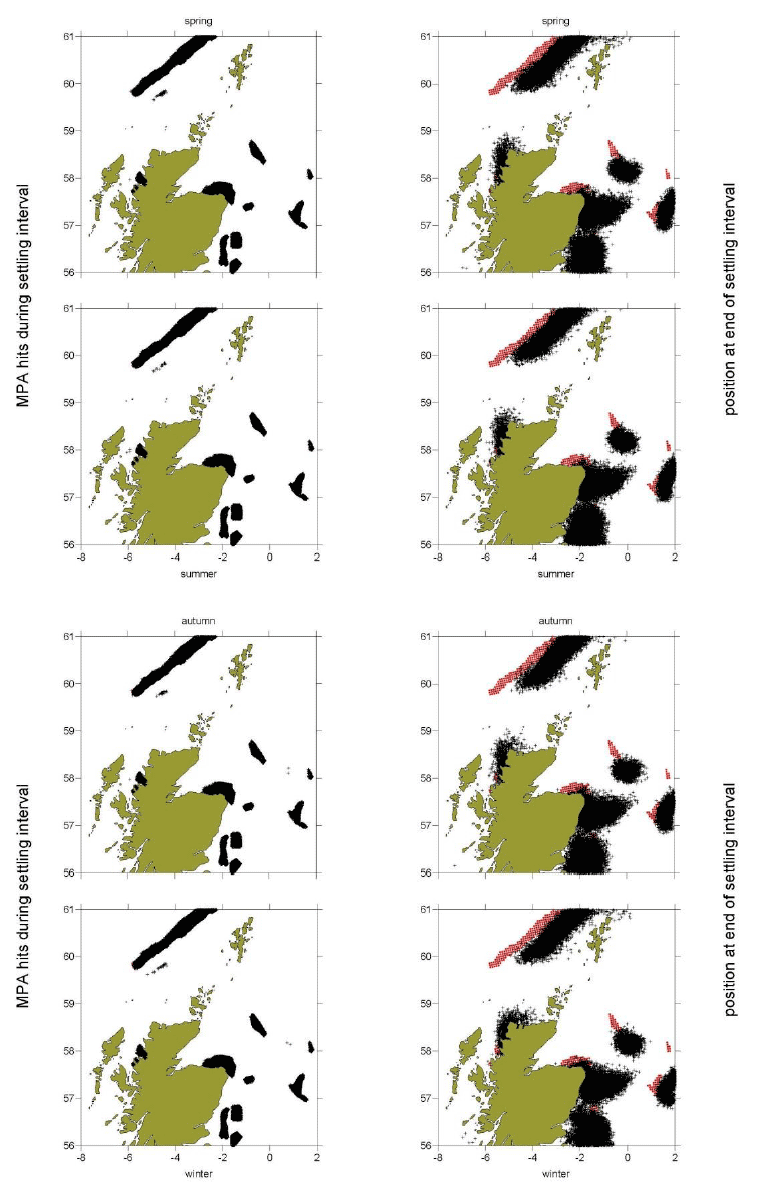
Table 13
Mean and standard deviation of the distance (straight line) between start and end position, for each particle representing amphipod offspring released from each origin MPA, for each spawning season (n is the number of particles released).
| MPA | spring | summer | autumn | winter | n | ||||
|---|---|---|---|---|---|---|---|---|---|
| mean | stdev | mean | stdev | mean | stdev | mean | stdev | ||
| NWS | 45.71541 | 19.9395 | 40.61786 | 18.85419 | 49.44458 | 20.30217 | 60.3965 | 23.25147 | 1200 |
| STR | 73.30068 | 17.13326 | 72.94866 | 17.12485 | 74.44586 | 18.12632 | 72.37808 | 19.24067 | 7600 |
| ARR | 29.70384 | 16.22294 | 29.56981 | 16.26043 | 28.08696 | 14.25608 | 27.70105 | 14.30954 | 1300 |
| GLE | 50.26104 | 18.6439 | 43.82027 | 16.52504 | 52.9068 | 19.21399 | 64.03978 | 21.8383 | 300 |
| EGM | 35.99597 | 11.65453 | 36.03197 | 11.9373 | 32.72312 | 10.17337 | 32.60442 | 9.312925 | 3800 |
| WFL | 52.03145 | 14.06442 | 45.3174 | 13.63996 | 54.99862 | 15.19404 | 55.52642 | 14.71882 | 3000 |
| NSP | 50.32005 | 7.560243 | 48.08747 | 7.108671 | 51.16166 | 7.499674 | 52.05183 | 7.24344 | 800 |
| BHT | 33.40955 | 16.599 | 34.53022 | 18.4953 | 43.34478 | 19.14527 | 48.62432 | 16.13506 | 18700 |
| FSS | 102.975 | 18.09356 | 101.692 | 17.26555 | 112.0983 | 17.61639 | 114.0385 | 18.46735 | 25500 |
| FOF | 25.78633 | 11.99884 | 27.46618 | 12.67583 | 29.98636 | 13.01473 | 31.95397 | 13.57806 | 8302 |
The results on Table 13 show relatively small differences between MPAs and seasons, compared to other species. The only origin MPA with greater dispersal potential than the rest is the Faroe-Shetland Sponge Belt ( FSS), due to its hydrographic characteristics.
Figure 13b shows a connectivity matrix between origin and (potential) destination MPAs. Most origin MPAs are quite retentive, given the biological characteristics of this species, with a small number of relative exceptions.
Figure 13b: Matrix showing the percentage of all particles representing amphipods released from each origin MPA drifting over any MPA during the settlement period of their pelagic phase. Grey boxes indicate zero hits.
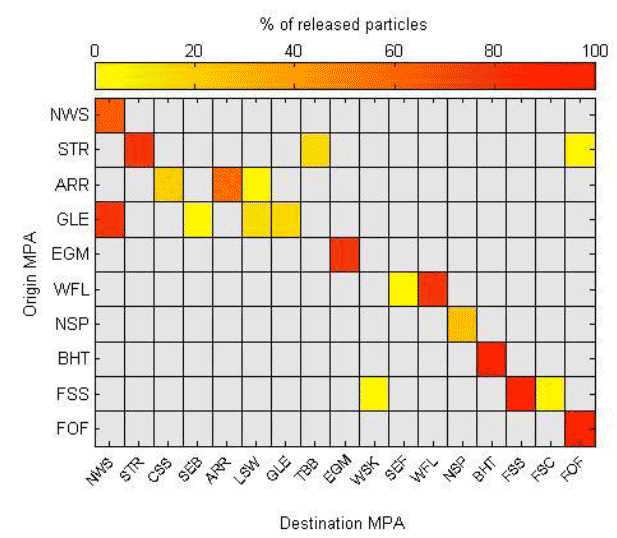
Spiny Lobster ( Palinurus elephas)
For the purpose of our connectivity simulations, spiny lobsters were assumed to spawn in summer as they produce a clutch from around July to October. Larvae may drift for one to six months so a settlement window of 60-180 days was used in the simulation. Based on presence data, particles were released from the following MPAs: SMI, NWS, STR and LSW.
Figure 14a shows the distribution of particles at the end of the settlement window (right panel) and identifies the MPAs locations that these particles drifted over during that period (left panel). The potential distribution of offspring and connectivity potential are extremely wide, given the long PLD period of this species. An index of the distance covered by the larvae in their PLD is presented in Table 14.
Figure 14a: Black dots show the distribution of particles at the end of the settlement window (right panel) and MPAs locations that these particles drifted over during that period (left panel). Red dots show the particle origin positions.

Table 14
Mean and standard deviation of the distance (straight line) between start and end position, for each particle representing spiny lobster larvae released from each origin MPA (n is the number of particles released).
| MPA | summer | n | |
|---|---|---|---|
| mean | stdev | ||
| SMI | 626.0166 | 197.1344 | 2400 |
| NWS | 690.7814 | 118.3799 | 1200 |
| STR | 481.381 | 202.9256 | 7600 |
| LSW | 139.3821 | 127.9197 | 100 |
The results on Table 14 show some differences between MPAs. The general pattern shows smaller distances closer inshore and more dispersive MPAs in the west, compared to the east coast.
Figure 14b shows a connectivity matrix between origin and (potential) destination MPAs. As with other species, west coast MPAs are more dispersive than North Sea ones. A relatively high proportion of offspring originating from the Loch Sween MPA have the potential to colonise MPAs in the Clyde area (Clyde Sea Sill ( CSS) and Arran ( ARR)).
Figure 14b: Matrix showing the percentage of all particles representing spiny lobster released from each origin MPA drifting over any MPA during the settlement period of their pelagic phase. Grey boxes indicate zero hits.
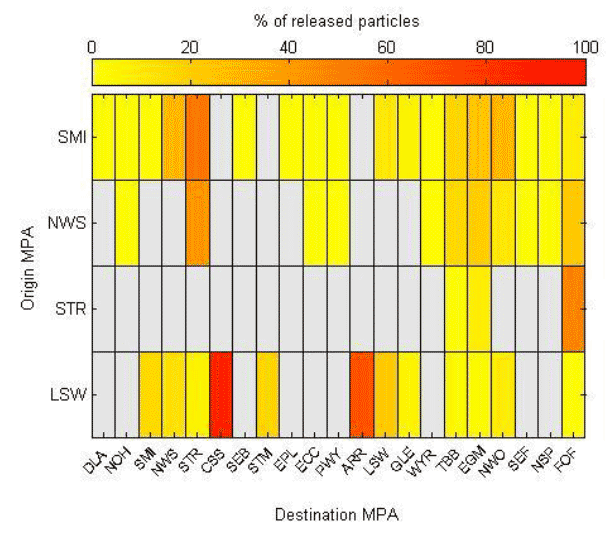
Echinodermata
Northern Feather Star ( Leptometra celtica)
The free-swimming vitellaria larvae of northern feather star only last a few days before settlement and so a settlement window of one to ten days was assumed. Due to the limited information on spawning times, we assumed that spawning occurred all year-round. Based on presence data, particles were released from the following possible MPAs; SMI, NWS, MTB and LSW.
Figure 15a shows the distribution of particles at the end of the settlement window (right panels) and identifies the MPAs locations that these particles drifted over during that period (left panels) for each of the spawning periods (top to bottom: spring to winter). The potential distribution of offspring is low, resulting from the short PLD period, and quite constant between seasons. An index of the distance covered by the larvae in their PLD is presented in Table 15.
Figure 15a: Black dots show the distribution of particles at the end of the settlement window (right panels) and MPAs locations that these particles drifted over during that period (left panels) for each of the spawning periods (rows from the top: spring to winter). Red dots show the particle origin positions.
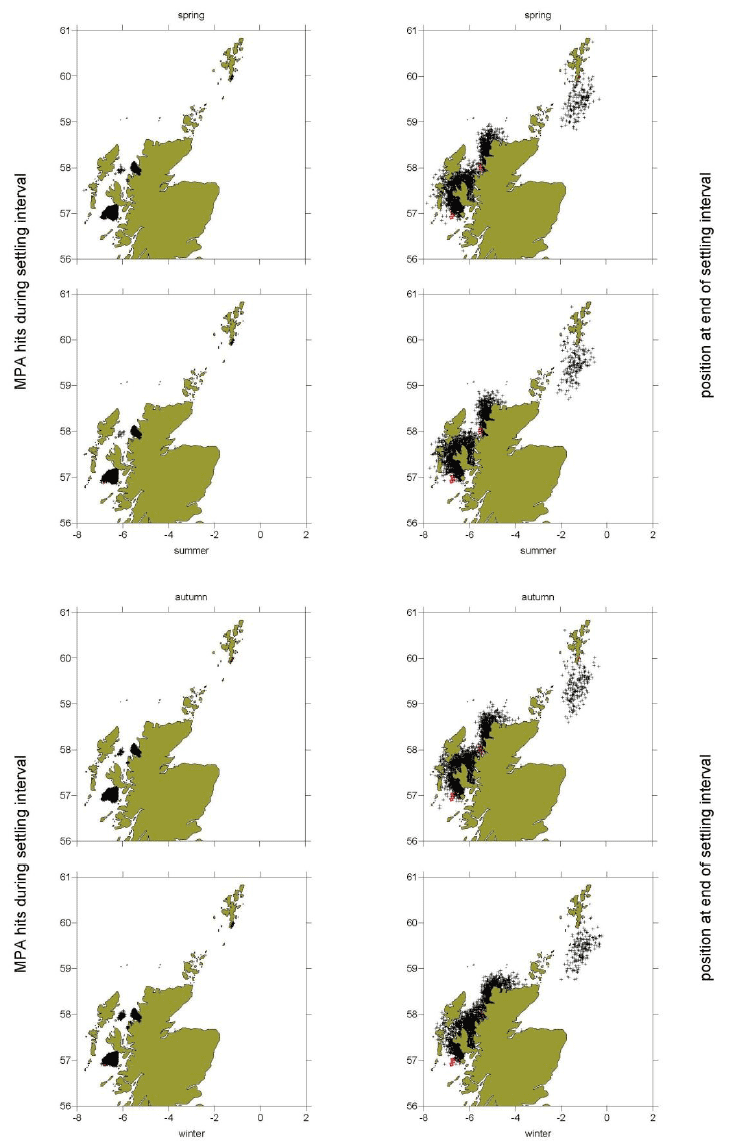
Table 15
Mean and standard deviation of the distance (straight line) between start and end position, for each particle representing northern feather star larvae released from each origin MPA, for each spawning season (n is the number of particles released).
| MPA | spring | summer | autumn | winter | n | ||||
|---|---|---|---|---|---|---|---|---|---|
| mean | stdev | mean | stdev | mean | stdev | mean | stdev | ||
| SMI | 58.80072 | 34.80895 | 58.93132 | 33.395 | 63.88066 | 37.24751 | 74.00236 | 45.65417 | 2400 |
| NWS | 52.20294 | 22.69311 | 46.40062 | 20.75867 | 57.20983 | 24.6535 | 72.89097 | 32.6751 | 1200 |
| MTB | 65.67233 | 26.93485 | 68.35814 | 29.93843 | 75.50844 | 29.67039 | 70.20467 | 26.56152 | 200 |
| LSW | 24.93985 | 20.92754 | 21.96786 | 22.63312 | 25.41234 | 25.30455 | 25.20322 | 21.74939 | 100 |
The results on Table 15 show relatively small differences between MPAs, with the exception of a very inshore one (Loch Sween ( LSW)) and seasons, although winter spawning was generally more dispersive.
Figure 15b shows a connectivity matrix between origin and (potential) destination MPAs. Inshore MPAs like LSW or North-west sea lochs and Summer Isles ( NWS) are more retentive (resulting in more self-recruitment) than further offshore MPAs.
Figure 15b: Matrix showing the percentage of all particles representing northern feather star released from each origin MPA drifting over any MPA during the settlement period of their pelagic phase. Grey boxes indicate zero hits.
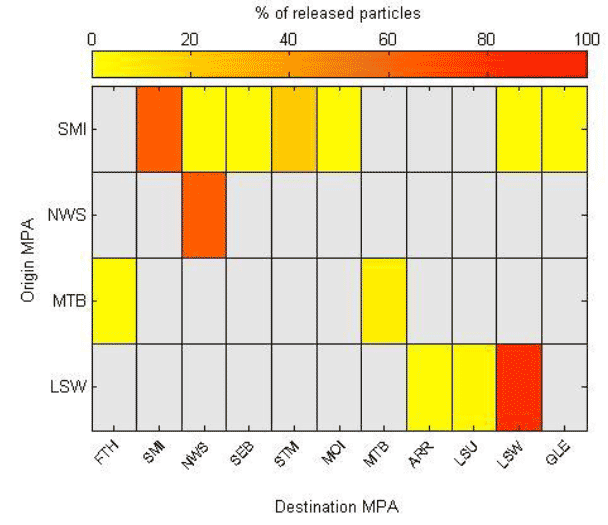
Analysis of General Patterns
The GAM fitted to mean transport distance estimates for each species, MPA and season (QUARTER: SPR, SUM, AUT, WIN) combination indicated that maximum pelagic larval duration ( PLDMAX; days) and Distance to shore (Distancetoshore; km) had a significant effect on mean transport distance (Table 16). However, only winter had a significantly greater transport rate than other quarters and OSPAR region was not significant when distance from shore was considered.
Table 16
Outcome of fitting successively more complex models up to the minimum adequate model ( GAM) to mean particle distance travelled.
| Model | d.f. | Deviance explained (%) | F-values | P-values |
|---|---|---|---|---|
| s( PLDMAX) | 1 | 49 | 28.49 | <0.001 |
| + fQuarter | 3 | 11.5 | 8.56 | <0.001 |
| + s(Distance to shore) | 1 | 5.6 | 4.38 | 0.017 |
Contact
There is a problem
Thanks for your feedback